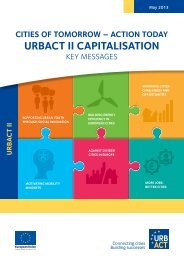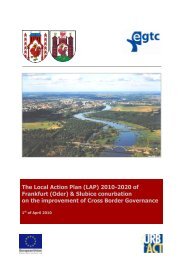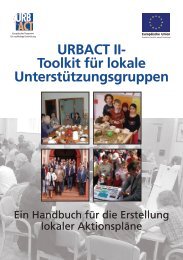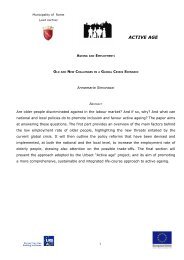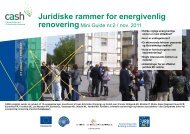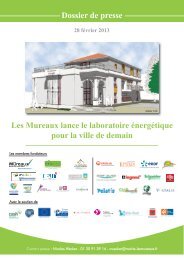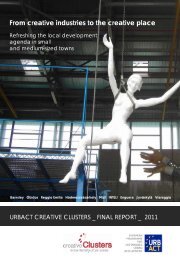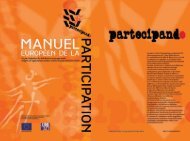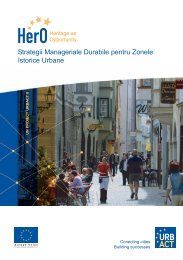ENTER.HUB_Baseline study PDF, 6 Mo - Urbact
ENTER.HUB_Baseline study PDF, 6 Mo - Urbact
ENTER.HUB_Baseline study PDF, 6 Mo - Urbact
You also want an ePaper? Increase the reach of your titles
YUMPU automatically turns print PDFs into web optimized ePapers that Google loves.
EUROPEAN<br />
UNION<br />
European Regional<br />
Development Fund<br />
for the city with the possible devolvement of decision making to local transport authorities; how Preston can<br />
benefit from the proposed Northern Hub? (http://www.networkrail.co.uk/aspx/6472.aspx); how Preston<br />
can ensure that the role of transport is integrated with meeting both Preston’s and Lancashire’s economic<br />
needs, enabling the development and delivery of business competitiveness and higher-value added business<br />
activity.<br />
ISSUE / PROBLEM THE PARTNER WANTS TO ADDRESS THROUGH THE LOCAL ACTION PLAN<br />
The issues / problems to be addressed through Preston’s Local Action Plan are to be determined but will<br />
include the issues relating specifically to territorial and urban actions 3 (hub as a urban centrality) and 4 (hub<br />
as a turbine, especially 4.a. synergy with the hub and the city, which Preston will coordinate), and strategic<br />
and transversal policies A (Communication/Governance/Participation), C (New technologies / smart cities), D<br />
(economic tools) and E (<strong>ENTER</strong>.<strong>HUB</strong> and EU policies). These will include governance issues around long term<br />
provision of services benefitting the city region, economically, socially and culturally in the context of<br />
franchise of rail services and decentralization of decision making. In particular this will focus on how the role<br />
of Preston as a sub-regional hub for Lancashire can be developed further. The Local Action Plan will link in with<br />
the new city centre masterplan currently under development and due to be included with the statutory<br />
Development Plan scheduled for approval by summer 2014.<br />
HOW THE PARTNER CAN BENEFIT FROM THE NETWORK AND WHAT THEY CAN BRING TO THE NETWORK<br />
Preston will lead on the territorial and urban action of synergy with the hub and the city (4a).<br />
Preston can contribute in particular to the territorial and urban actions of urban centrality (3) and the hub as a<br />
turbine (4), and all of the strategic and transversal policies. Our potential contribution lies in sharing<br />
experiences of the governance and economic challenges faced in a polycentric context where there is a<br />
multiplicity of urban players and key stakeholders and an absence of strong collective governance priorities<br />
(strategic and transversal policy C and D).<br />
We expect to learn from other cities’ regarding the issues they have faced or are facing in developing their<br />
hubs and surrounding areas for example. The territorial and urban actions and strategic and transversal policies<br />
identified and to be explored through transnational exchange all have relevance to Preston’s position as a railhub<br />
for the wider Lancashire sub-region.<br />
12 - City of Rostock, GERMANY - convergence<br />
204.000 inhabitants, 255.000 in the metropolitan area<br />
LOCAL SITUATION REGARDING THE TOPIC<br />
We expect finishing the upgrade of the railway track to the capital Berlin until 2015. We already have one high<br />
speed connection by ICE. A competitive railway connection to Hamburg already exists.<br />
Rostock Main Station represents the main Hub for passenger transport in Mecklenburg‐Vorpommern. Its<br />
importance results on the one hand on the 500.000 inhabitants and the growing number of working commuters<br />
an on the other hand of the enormous growing number of tourists. We need a strategic position for our railway<br />
system how to connect with the ferry harbour and the airport in higher quality. We define the regional<br />
relevance also towards our south Baltic partners.<br />
In addition, Rostock is one of the few growing regions in former eastern Germany, ideal located in the<br />
metropolitan city triangle (Berlin‐Hamburg‐Copenhagen).<br />
MAIN EXPECTATIONS VIS-A-VIS THE NETWORK<br />
The main railway station was developed in 2002/03 by ERDF grants. The hinterland of the railway station is an<br />
underdeveloped (aprox. 110 ha) area with high urban development potentials. The development of the area<br />
was started in the early seventies. It hasn´t been finished yet.<br />
This area is one of the last larger underdeveloped areas in Rostock nearby inner city and well connected by<br />
public transport system (local, regional and far). The thematic is very complex. Only local expert staff<br />
experience is not enough to cover the challenges and potentials of the location.<br />
We have just started first thoughts about a structural development plan for the area near the station.<br />
Therefore we need to be network partner and to get external support to elaborate the URBACT methodology<br />
(with LAP and ULSG to get more inspiration and harmonized engagement and to bridge over the gap between<br />
spatial planning and investment).<br />
<strong>ENTER</strong>.<strong>HUB</strong> <strong>Baseline</strong> <strong>study</strong> 2012.10.31<br />
45



